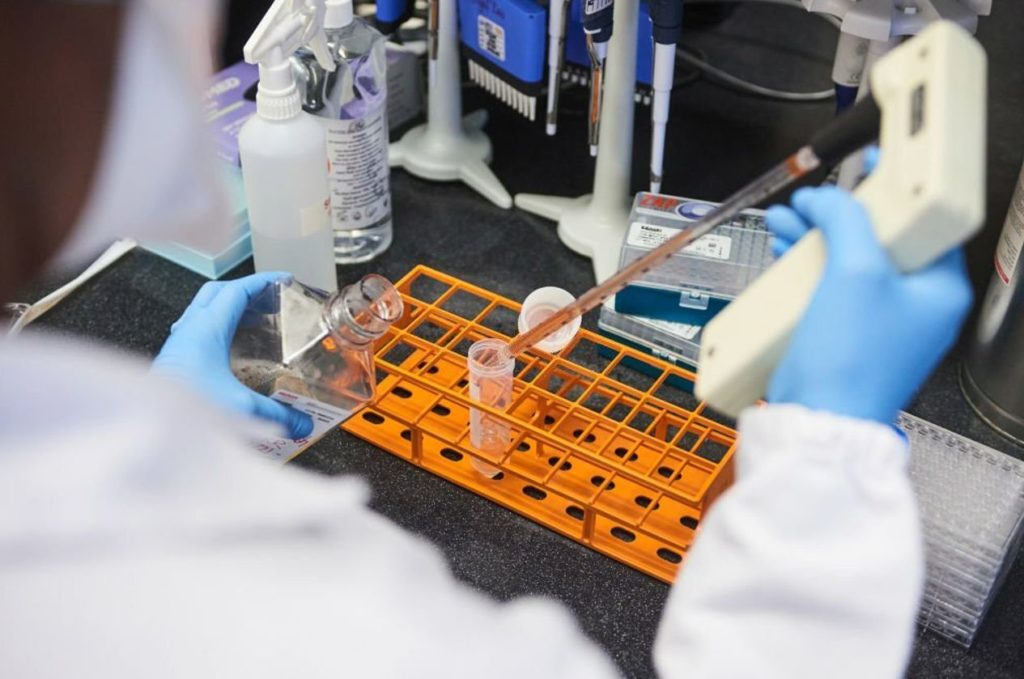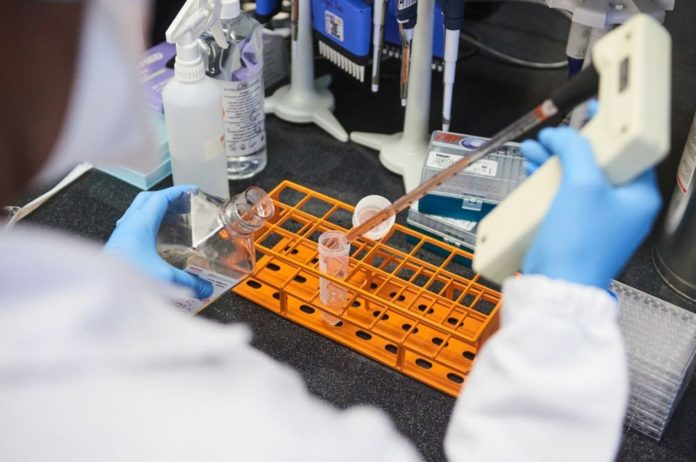Alpaca nanobodies bind to and kill viruses up to 1000 times better than previously developed mini-antibodies.
Mini-antibodies created by Göttingen researchers effectively prevent the coronavirus SARS-CoV-2 and its deadly new variants. Nanobodies bind to and kill viruses up to 1000 times better than previously produced mini-antibodies.
In addition, the scientists improved the stability and heat resistance of their mini-antibodies. They are promising medications for treating COVID-19 because of their unique combination.
As nanobodies can be manufactured in vast quantities at low cost, they may be able to address the global need for COVID-19 therapies. Clinical trials for novel nanobodies are now being planned.

Antibodies help our bodies fight off infections. The molecules, for example, connect to viruses and neutralize them, preventing them from infecting cells. Antibodies can also be manufactured industrially and given to critically ill individuals. They then function like drugs, reducing symptoms and speeding up the recovery process. For the treatment of hepatitis B and rabies, this is standard procedure. COVID-19 patients are also treated with antibodies. However, industrial-scale production of these compounds is too complicated and costly to meet global demand. This is a problem that nanobodies may be able to solve.
Mini-antibodies (also known as VHH antibodies or nanobodies) have been developed by scientists at the Max Planck Institute (MPI) for Biophysical Chemistry in Göttingen (Germany) and the University Medical Center Göttingen (UMG) that combine all of the properties required for a potent drug against COVID-19.
“For the first time, they combine extreme stability and outstanding efficacy against the virus and its Alpha, Beta, Gamma, and Delta mutants,” says Dirk Görlich, director at the MPI for Biophysical Chemistry.
The novel nanobodies appear to be quite similar to anti-SARS-CoV-2 nanobodies developed by other labs at first inspection. They’re all aimed against a critical component of coronavirus spikes: the receptor-binding domain, which the virus uses to infect host cells. The nanobodies obstruct the virus’s binding domain, preventing it from infecting cells.
“Our nanobodies can withstand temperatures of up to 95 °C without losing their function or forming aggregates,” adds Matthias Dobbelstein. “For one thing, this tells us that they might remain active in the body long enough to be effective. For another, heat-resistant nanobodies are easier to produce, process, and store.”
Nanobodies against SARS-CoV-2 variants
The Göttingen team’s simplest mini-antibodies bind up to 1000 times more strongly to the spike protein than previously reported nanobodies. They also bind very effectively to the Alpha, Beta, Gamma, and Delta strains’ altered receptor-binding domains.
“Our single nanobodies are potentially suitable for inhalation and thus for direct virus neutralization in the respiratory tract,” adds Dobbelstein. “In addition, because they are very small, they could readily penetrate tissues and prevent the virus from spreading further at the site of infection.”
A ‘nanobody triad’ increases binding even more: According to the symmetry of the spike protein, which is made up of three similar building blocks with three binding domains, the researchers bundled three identical nanobodies.
“With the nanobody triad, we literally join forces: In an ideal scenario, each of the three nanobodies attaches to one of the three binding domains,” says Thomas Güttler, a scientist in Görlich’s team.
“This creates a virtually irreversible bond. The triple will not let release the spike protein and neutralizes the virus even up to 30,000-fold better than the single nanobodies.”
Another benefit is that the nanobody triad’s bigger size causes renal excretion to take longer. This prolongs their stay in the body and ensures a longer-lasting therapeutic effect.
The scientists created tandems as a third design. These nanobodies combine two nanobodies that each target a separate portion of the receptor-binding domain and can bind the spike protein when used together.
“Such tandems are extremely resistant to virus mutations and the resulting ‘immune escape’ because they bind the viral spike so strongly,” highlights Metin Aksu, a researcher in Görlich’s team.
The researchers discovered that relatively modest levels of all nanobody forms — monomeric, double, and triple — are enough to kill the infection. If this were to be utilized as a medicine, it would allow for a lower dosage, resulting in fewer adverse effects and reduced production costs.
An alpaca immunised with SARS-CoV-2 antigens
“Our nanobodies originate from alpacas and are smaller and simpler than conventional antibodies,” Görlich adds.
Three alpacas from the MPI for Biophysical Chemistry’s herd, Britta, Nora, and Xenia, were inoculated with portions of the coronavirus spike protein to develop the nanobodies against SARS-CoV-2. After that, the mares developed antibodies, and the scientists took a little blood sample from them. The objective was then completed for the alpacas, since all further processes were carried out using enzymes, bacteria, so-called bacteriophages, and yeast.
“The overall burden on our animals is very low, comparable to vaccination and blood testing in humans,” says Görlich.
The alpacas’ blood yielded about one billion blueprints for nanobodies, according to Görlich’s researchers. The biochemists next utilized bacteriophages to choose the best nanobodies from a large pool of candidates, a laboratory technique that had been developed over many years. These were subsequently put to the test against SARS-CoV-2, and their potency was improved in subsequent rounds of tuning.
Not all antibodies are ‘neutralizing.’ As a result, Dobbelstein’s team investigated whether and how efficiently nanobodies inhibit viruses from reproducing in lab-grown cells.
“By testing a wide range of nanobody dilutions, we find out which quantity suffices to achieve this effect,” explains Antje Dickmanns. “Some of the nanobodies were really impressive. Less than a millionth of a gram per liter of medium was enough to completely prevent infection. In the case of the nanobody triads, even another twenty-fold dilution was sufficient.”
Also work against emerging COVID-19 variants
New viral strains evolved throughout the coronavirus pandemic and quickly became prevalent. These variants are frequently more contagious than the original Wuhan strain (China). Their altered spike protein can also evade neutralization by some antibodies that were previously successful in infected, recovered, or vaccinated people. Even an immune system that has been taught to remove the virus will find it more difficult to do so. This issue also affects therapeutic antibodies and nanobodies that have already been created.
The novel nanobodies’ full potential is demonstrated here, as they are also effective against the primary coronavirus types of concern. The researchers had given their alpacas a portion of the first known SARS-CoV-2 virus’s spike protein, yet the animals’ immune systems developed antibodies that were active against the many virus types.
“Should our nanobodies prove ineffective against a future variant, we can reimmunize the alpacas. Since they have already been vaccinated against the virus, they would very quickly produce antibodies against the new variant,” says Güttler.
A promising therapeutic candidate against several SARS-CoV-2 variants
The nanobodies are being made for medical use by the Göttingen team. Dobbelstein underlines: “We want to test the nanobodies as soon as possible for safe use as a drug so that they can be of benefit to those seriously ill with COVID-19 and those who have not been vaccinated or cannot build up an effective immunity.”
SARS-receptor-binding CoV-2’s domain is a good candidate for a protein vaccine, but it’s been challenging to produce on a big scale and in a form that stimulates the immune system against the virus.
Bacteria that have been programmed in this way create material that is wrongly folded. The Göttingen researchers found a solution to this difficulty when they discovered unique nanobodies that encourage proper folding in bacterial cells without impeding the receptor-binding domain’s critical neutralizing component.
This could lead to vaccinations that are low-cost to develop, adapt fast to new viral types, and disseminate using simple logistics even in places with little infrastructure.
“The fact that nanobodies can help with protein folding was previously not known and is extremely interesting for research and pharmaceutical applications,” Görlich says.
Source: 10.15252/embj.2021107985
Image Credit: Getty
You were reading: Alpaca nanobodies effectively kill COVID-19 and its variant – 1000 times better
